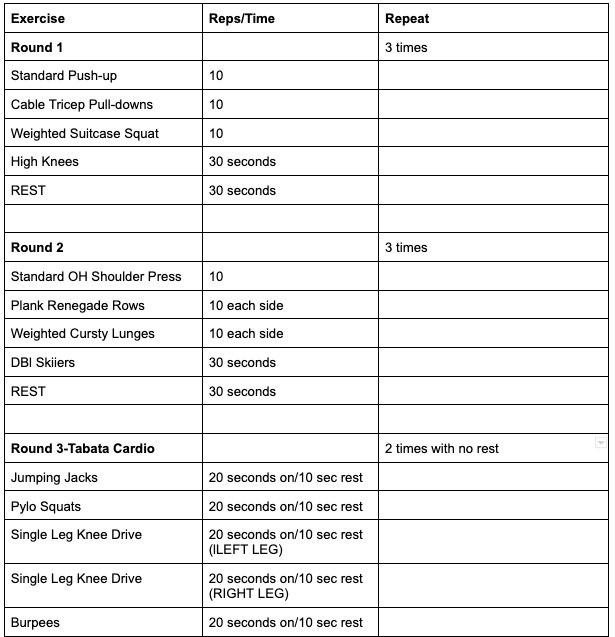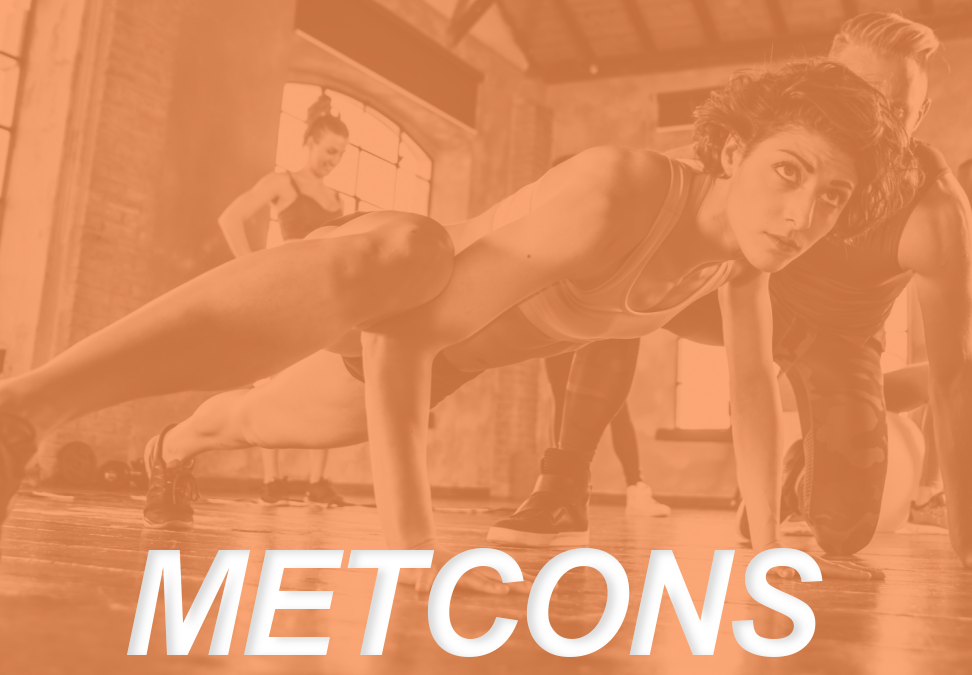Many fitness clients hire trainers to lose weight and see results fast. While part of our initial conversations during intake is to level expectations and explain healthy average weight loss varies between 1-2lbs per week, we also know there are certain methods of training that are going to fit more in line with what each of our clients are seeking. One of my personal favorite styles of training is “MetCon”, or metabolic conditioning. For my clients that train with me two days a week, incorporating MetCons has been a game-changer (in combination with improved diet habits, of course).
Why Steady-State Cardio Fails
The majority of your new fitness clients hold the misconception that increased cardio automatically yields increased fat loss. We as trainers know that gym-goers solely relying on time spent in steady-state cardio on the ellipticals and treadmills to get the job done are unlikely to see the results they’re hoping for because:
1) This approach to cardio only without resistance training can be boring which is why it seems/feels like a chore 2) There is no variance between heart rate zones so there’s minimal improvement in cardiovascular health as the body adapts quickly to the same workout intensity and duration.
If you can easily watch and enjoy a full Netflix show during your “cardio” session, your body most likely isn’t working hard enough to fluctuate between the heart rate zones necessary to improve heart rate variability; varying intensities in aerobic activity have demonstrated improvements in long-term cardiovascular health needed to prevent the risk of disease, as well as achieve fat loss.
Many think they’ve found a way to short circuit the disdain for cardio by distracting with social media or entertainment while they put in their time on a cardio machine. This explains why many overweight folks are still capable of running marathons: their bodies have adapted endurance-wise but they have not adopted a method of training that effectively allows their body to use and store energy and, in turn, alters the metabolism to obtain more visible results.
Is HIIT the answer?
Now enter High-Intensity Interval Training. HIIT training has become slightly “trendy” over the last decade. It’s no surprise that it’s attractive to many, especially for those that dislike steady-state cardio. “You mean I can burn more calories in a shorter amount of time if I just ramp up the intensity? Count me in!”
Again though, we run into the problem of adaptation. Exercises don’t need to be fancy or complicated to get the job done but they do need to have some sort of progression built-in in order to get the benefits from the Overload Training Principle. This is where metabolic conditioning can have a tremendous impact on pushing through those adaptation barriers and heart rate variability.
What is MetCon?
It’s more than just high-intensity-interval training. MetCon is a style of training that provides intentional stimulation of the body’s systems to reset an individuals’ metabolism. This in turn will mean more efficient fat utilization and ultimately higher rates of fat loss.
To understand why metabolic conditioning is an effective form of training we must also understand the three energy systems recruited during exercise to get that lovely “afterburn” or EPOC that fit pros like to tout. Essentially, your body is continuing to burn calories post-workout even as your heart rate returns to normal levels.
The three energy systems recruited during this type of exercise are phosphagen (ATP-PC), glycolytic, and oxidative.
1) The phosphagen system harnesses ATP through high-intensity exercises with a duration of 10-30 seconds, such as plyometrics.
2) The glycolytic system utilizes carbs to produce ATP for exercises with a duration of 30 seconds to 3 minutes. Both the phosphagen and glycolytic systems are anaerobic (absence of oxygen).
3) The oxidative system uses oxygen (as the name implies), to help with energy production. However, rather than generating energy through the use of carbohydrates like the glycolytic system, the oxidative system uses proteins and fats. This type of system comes into play with activities such as long distance running.
To create an effective MetCon workout for your client, you must understand their target heart rate and RPE for cardio-focused exercises. The RPE scale goes from 0 (no exertion at all), 5 (with 70% effort, where talking is hard but talking is relatively easy) up to level 10 (95-100% effort there is a high level of discomfort and talking is impossible).
Once you have those numbers handy with the feedback from your client, you can create workouts that will recruit the systems necessary to revamp your client’s metabolism and take advantage of that “afterburn” by getting them into the three target heart rate zones.
Programming MetCons
When I structure my client’s workouts to fit this style of training it usually resembles an outline like this falling into either a 2 or 3 day split:
-Push Exercise
-Pull Exercise
-Squat Exercise
I have my clients work through 2-3 sets of weighted/resistance exercises. Fat loss clients are going to see a 20-25 rep range and either option:
- Break up each set with 30-60 seconds of a HIIT exercise at the end before returning to the top of the first exercise for the next set.
- Complete all of the lifting exercise sets and move on to a high-intensity burnout round at the end of the workout consisting of either Tabata or Pyramid style.
A standard Tabata round would consist of 4-6 exercises with a 20-second working period followed by 20 seconds of rest. You always have the option of working your beginner clients up to this duration and intensity by starting out first with a reverse Tabata; 10 seconds of work with 20 seconds of rest or an equal work-to-rest ratio of 15 on/15 off.
High knees, jumping jacks, jump squats, squat jacks, or jump ropes are a few of my go-to HIIT exercises that can also be modified depending on client level.
For a Pyramid training metcon option you are building on exercise reps so you would start out with the lowest amount of reps and build upwards, and then come back down to your starting rep range. It would look like this: 2-4-6-8-10-8-6-4-2. This is a very time-efficient way to boost that heart rate and get in max reps.
A sample workout could look something like this:

As the body begins to fatigue, the reps come down and it’s really a testament to mental endurance as well as physical. Both methods are ideal in getting that final burst in heart rate, especially by incorporating lighter weights into more explosive movements such as dumbbell skiers or weighted squat jacks.
High Intensity Vs. High Impact Movements
Remember, high intensity does not have to equate to high impact. Clients with joint concerns can still reap the benefits of metcon training without sacrificing joint comfort utilizing HILIT as an approach. As trainers we must prioritizing improving clients’ ADLs (activities of daily living) so keeping your client’s goals in mind is imperative over your own desire to prove yourself as a trainer with a quick physical transformation.
We have to strike a balance between slow, sustainable progress providing enough challenge that clients feel pushed out of their comfort zones, but not so sore that they feel discouraged. A poor experience with a personal trainer could turn someone off from working with one or even exercising indefinitely. Be sure to assess RPE to distinguish between pain and discomfort, modifiying when necessary.
Cooling Down
Always make time for a few deep breaths bridging into a cool-down stretch allowing for heart rate to come down before moving on with their day. This also prevents dizziness and orthostatic hypotension if they perform transitions from floor to standing exercises in a short time.
Emphasis on stretching and cool down is just as important as the workout itself. Don’t let your clients skip it as this aids in their recovery. Addressing and explaining DOMS in beginner clients is a very important to again level expectations so they won’t want to quit after the first few sessions. Even as a beginner trainer, you can ensure your client’s success by sporting a positive attitude and shifting their perspective on what it means to exercise and move their bodies with intention.


